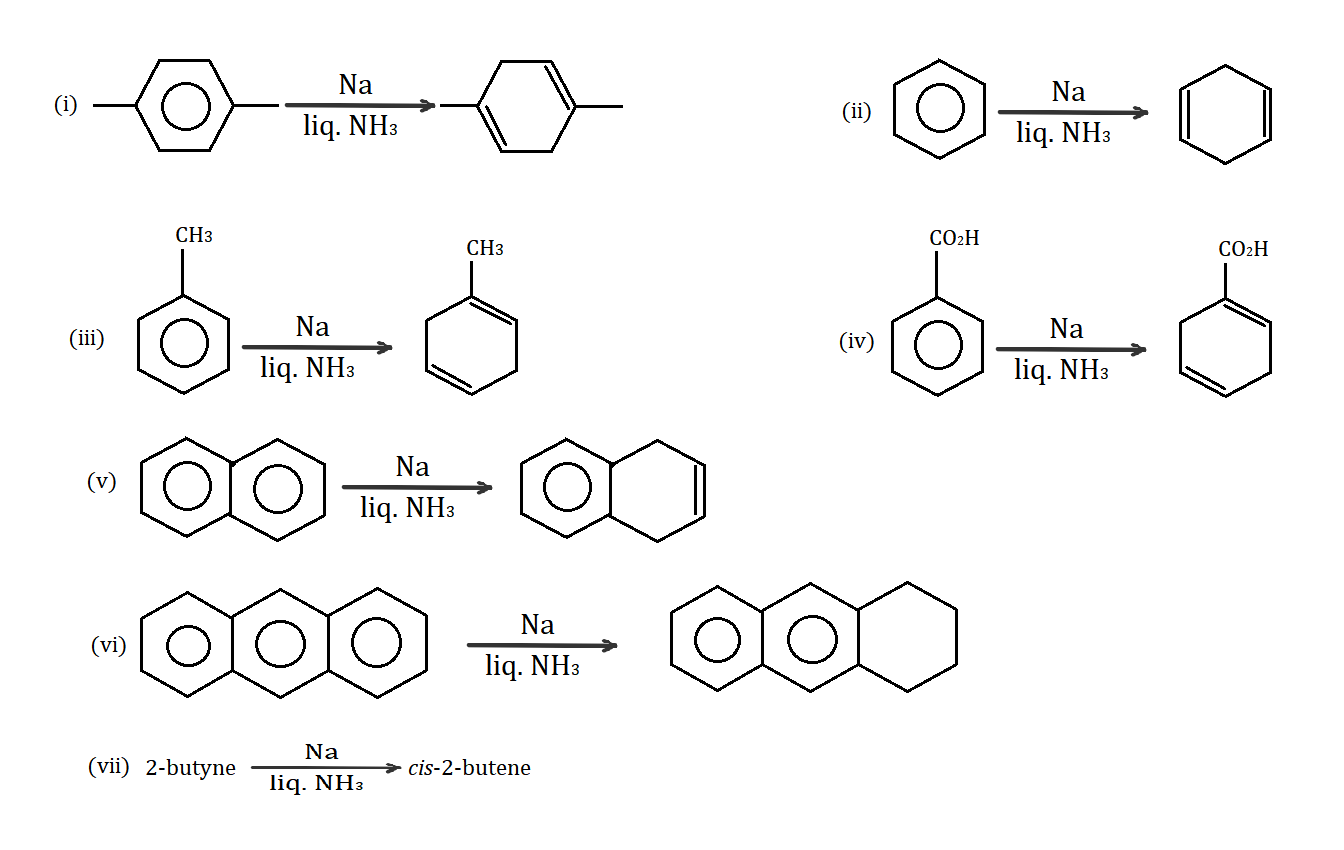
Which of the following reactions do not present in the major product of the given Birch reductions?

(A) (i), (iii), (iv)
(B) (iv), (vi), (vii)
(C) (iv), (v), (vi)
(D) (i), (ii), (v), (vii)

Answer
512.7k+ views
Hint :The Birch Reduction is the process in which benzene (and its aromatic relatives) is converted to $ 1,4 - $ cyclohexadiene using sodium (or lithium) as a reducing agent in liquid ammonia as solvent (boiling point: $ - 33^\circ C $ ) in the presence of an alcohol such as ethanol, methanol or t-butanol. Here, $ Na $ acts as a reducing agent in the presence of liquid $ N{H_3} $ .
Complete Step By Step Answer:
Reaction (i) satisfies the Birch reduction as there is a formation of $ 1,4 - $ cyclohexadiene ring from a benzene ring.
Reaction (ii) also satisfies the Birch reduction as benzene is simply converted to $ 1,4 - $ cyclohexadiene.
Reaction (iii) also satisfies the Birch reduction as Toluene (an aromatic compound) is converted to $ 1 - $ methyl $ - 1,4 - $ cyclohexadiene.
Reaction (iv) does not satisfy the Birch reduction. In Benzoic acid, $ COOH $ is an electron withdrawing group. On treatment with $ Na $ in the presence of $ N{H_3} $ , it results in the protonation of carbon which has the electron withdrawing group, like $ COOH $ , where the electron is transferred to oxygen (which is more stable) due to regioselectivity. However, in birch reduction, only the phenyl group needs to be protonated and not the functional groups.
Reactive (v) satisfies the birch reduction. Here, naphthalene gets converted into $ 1,4 - $ dihydronaphthalene.
Reactive (vi) does not satisfy the birch reduction. Here, anthracene only loses one double bond and forms conjugate to become $ 9,10 - $ dihydroanthracene.
In reaction (vii), neither the reactants nor the products have a benzene ring or any other aromatic compound. It does not qualify for birch reduction.
Hence, the correct option is B.
Note :
You should be clear that birch reduction occurs only with $ Na/N{H_3} $ . It should not be confused with $ NaN{H_2}/N{H_3} $ . Also, you might sometimes replace $ C - H $ with anyne, $ N{H_2} $ which is again incorrect.
Complete Step By Step Answer:
Reaction (i) satisfies the Birch reduction as there is a formation of $ 1,4 - $ cyclohexadiene ring from a benzene ring.
Reaction (ii) also satisfies the Birch reduction as benzene is simply converted to $ 1,4 - $ cyclohexadiene.
Reaction (iii) also satisfies the Birch reduction as Toluene (an aromatic compound) is converted to $ 1 - $ methyl $ - 1,4 - $ cyclohexadiene.
Reaction (iv) does not satisfy the Birch reduction. In Benzoic acid, $ COOH $ is an electron withdrawing group. On treatment with $ Na $ in the presence of $ N{H_3} $ , it results in the protonation of carbon which has the electron withdrawing group, like $ COOH $ , where the electron is transferred to oxygen (which is more stable) due to regioselectivity. However, in birch reduction, only the phenyl group needs to be protonated and not the functional groups.
Reactive (v) satisfies the birch reduction. Here, naphthalene gets converted into $ 1,4 - $ dihydronaphthalene.
Reactive (vi) does not satisfy the birch reduction. Here, anthracene only loses one double bond and forms conjugate to become $ 9,10 - $ dihydroanthracene.
In reaction (vii), neither the reactants nor the products have a benzene ring or any other aromatic compound. It does not qualify for birch reduction.
Hence, the correct option is B.
Note :
You should be clear that birch reduction occurs only with $ Na/N{H_3} $ . It should not be confused with $ NaN{H_2}/N{H_3} $ . Also, you might sometimes replace $ C - H $ with anyne, $ N{H_2} $ which is again incorrect.
Recently Updated Pages
Why are manures considered better than fertilizers class 11 biology CBSE

Find the coordinates of the midpoint of the line segment class 11 maths CBSE

Distinguish between static friction limiting friction class 11 physics CBSE

The Chairman of the constituent Assembly was A Jawaharlal class 11 social science CBSE

The first National Commission on Labour NCL submitted class 11 social science CBSE

Number of all subshell of n + l 7 is A 4 B 5 C 6 D class 11 chemistry CBSE

Trending doubts
Differentiate between an exothermic and an endothermic class 11 chemistry CBSE

10 examples of friction in our daily life

One Metric ton is equal to kg A 10000 B 1000 C 100 class 11 physics CBSE

Difference Between Prokaryotic Cells and Eukaryotic Cells

1 Quintal is equal to a 110 kg b 10 kg c 100kg d 1000 class 11 physics CBSE

State the laws of reflection of light




